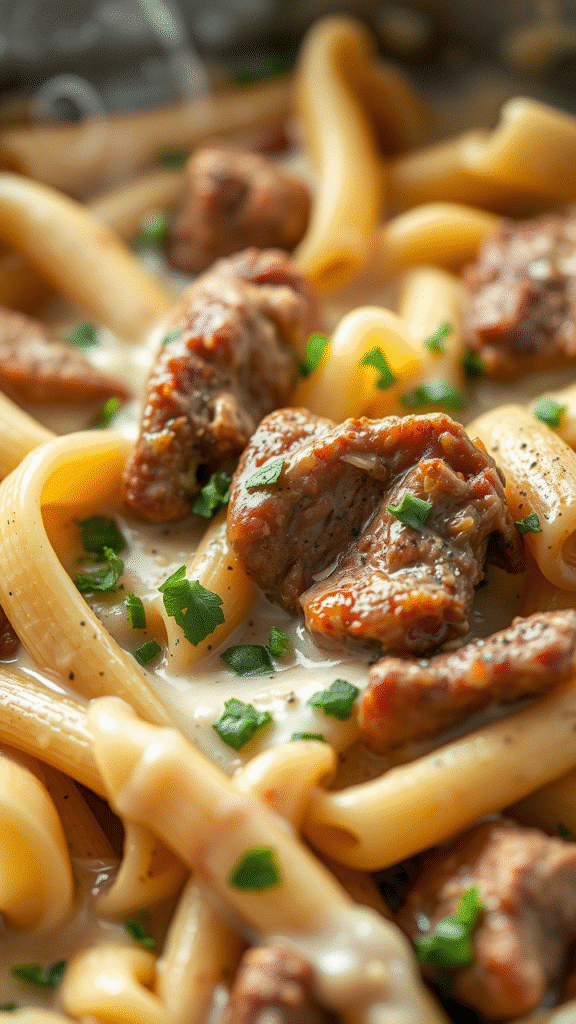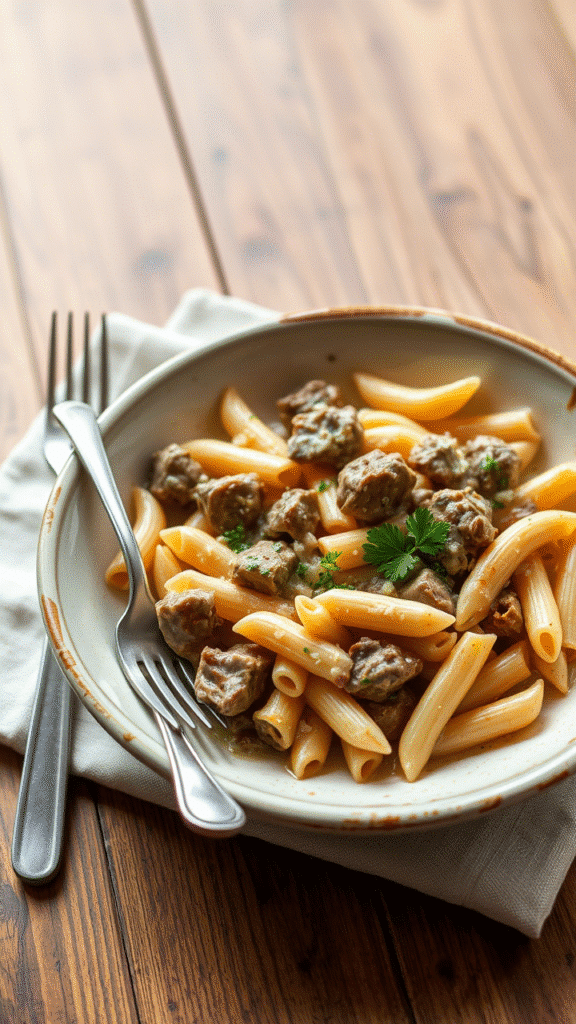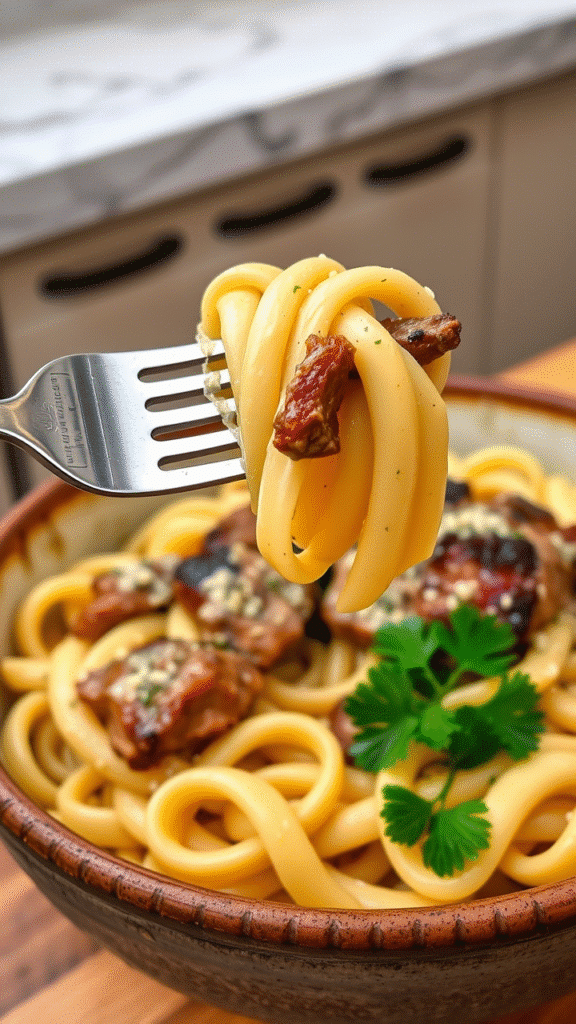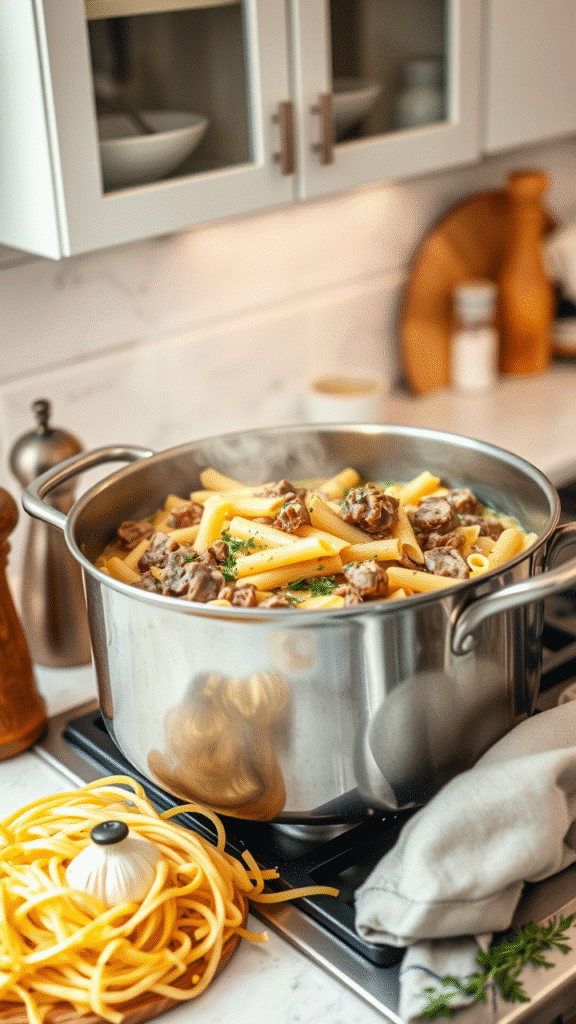Picture this: it’s 7 PM on a Tuesday, the dinner rush is about to hit, and you need something that’ll make your customers forget they’re eating comfort food that took just twenty minutes to prepare. That’s exactly what happened in my kitchen three years ago when I first stumbled upon this game-changing one-pot wonder. The aroma alone garlic butter melding with perfectly seared beef and cream had my sous chefs abandoning their stations just to peek over my shoulder.
This isn’t your grandmother’s beef stroganoff, though it carries the same soul-warming appeal. One-pot creamy beef and garlic butter pasta represents the evolution of comfort cooking, where traditional French techniques meet modern efficiency demands. The magic lies in building layers of flavor directly in the pot, allowing each ingredient to contribute to a symphony that’s somehow greater than it’s individual parts.
What makes this dish truly special isn’t just it’s convenience though cooking everything in one vessel certainly helps with cleanup. It’s the way the pasta absorbs the beef drippings and garlic-infused butter, creating a cohesive sauce that clings to every strand. The starch released from the pasta acts as a natural thickener, eliminating the need for flour-based roux while creating that glossy, restaurant-quality finish that home cooks often struggle to achieve.
Ingredients & Substitutions

The Protein Foundation
Start with 1 pound of sirloin steak, cut into bite-sized strips against the grain. The key here is selecting meat with good marbling those thin white lines of fat that’ll render down and contribute to your sauce’s richness. If sirloin’s not available, ribeye works beautifully, though it’s pricier. For budget-conscious operations, chuck roast can work, but you’ll need to increase cooking time significantly.
Ground beef makes an acceptable substitute, though you’ll lose the textural contrast that makes this dish memorable. Use 80/20 blend for optimal fat content. Avoid anything leaner than 85/15 you need that fat for flavor development.
The Aromatic Base
Six cloves of fresh garlic, minced fine, form the aromatic backbone. Don’t even think about using pre-minced garlic from a jar the sulfur compounds that create garlic’s pungency dissipate quickly once processed. Fresh garlic releases these compounds when crushed, creating that sharp bite that mellows into sweet nuttiness under heat.
One medium yellow onion, diced small, provides the necessary sweetness balance. Shallots work even better if you’re feeling fancy they’ve got that subtle complexity that elevates the entire dish without overwhelming the garlic.
Pasta Selection Matters
Twelve ounces of penne or rigatoni work best here. The tubes catch and hold the creamy sauce while providing enough surface area for proper starch release. Fusilli’s spirals work similarly, though the texture’s slightly different. Avoid long pasta like spaghetti or linguine they don’t integrate as well in one-pot preparations.
For gluten-free options, chickpea or lentil pasta performs surprisingly well. The extra protein actually enhances the dish’s heartiness, though cooking times vary significantly from wheat pasta.
Building the Cream Base
Heavy cream a full cup creates that luxurious mouthfeel we’re after. Half-and-half won’t cut it; the lower fat content means it’ll break under heat, leaving you with a grainy, separated mess. For dairy-free versions, full-fat coconut cream works, though it adds a subtle tropical note that some find off-putting.
Two cups of beef broth provide the cooking liquid for your pasta. Quality matters enormously here homemade stock trumps store-bought every time, but if you’re using commercial broth, choose low-sodium versions so you control the salt level. Chicken broth works in a pinch, though you’ll lose some of the beefy depth.
The Butter Component
Four tablespoons of unsalted butter, added at different stages, create layers of richness. European-style butter with higher fat content produces superior results the extra butterfat means less water, which translates to better browning and flavor concentration.
Seasoning Essentials
Salt and freshly cracked black pepper seem obvious, but timing matters. Salt the beef before cooking for better penetration. White pepper works beautifully in cream sauces if you prefer avoiding black specks in the final presentation.
Half a teaspoon of Italian seasoning ties everything together, though making your own blend—equal parts dried basil, oregano, and thyme produces more vibrant results. Fresh herbs added at the end provide that bright, herbaceous lift that keeps the dish from feeling too heavy.
Step-by-Step Instructions

Preparing Your Mise en Place
Before you even think about turning on the heat, get everything prepped and within arm’s reach. This dish moves quickly once you start, and there’s no time for last-minute chopping. Cut your beef into uniform pieces about three-quarter inch cubes work perfectly. Inconsistent sizing means some pieces overcook while others remain tough.
Pat the beef completely dry with paper towels, then season generously with salt and pepper. Let it sit at room temperature for at least fifteen minutes. This step’s crucial cold meat hitting hot oil creates steam, preventing proper browning.
The Searing Stage
Heat two tablespoons of neutral oil in your heavy-bottomed pot over medium-high heat. A Dutch oven works beautifully here, though any wide, heavy pot will do. The key is having enough surface area to brown the beef without crowding.
When the oil shimmers and just begins to smoke, add the beef in a single layer. Don’t move it for the first two minutes seriously, resist the urge to poke and prod. You’re building a foundation of flavor through the Maillard reaction, and disturbing the meat prevents proper browning.
The beef should release easily from the pot’s bottom when properly seared. If it’s sticking, it’s not ready to flip. Once nicely browned on one side, stir and continue cooking until all surfaces develop that golden-brown crust. This takes about five to six minutes total.
Building the Aromatic Base
Remove the beef to a plate, leaving behind those beautiful brown bits that’s liquid gold for flavor development. Reduce heat to medium and add two tablespoons of butter to the pot. As it melts and foams, add your diced onion.
Cook the onion until softened and translucent, about three minutes. Now add the minced garlic, stirring constantly for just thirty seconds until fragrant. Don’t let it brown burnt garlic tastes bitter and ruins everything.
This is where many home cooks go wrong. They either don’t cook the onion long enough, leaving it harsh and raw-tasting, or they burn the garlic by adding it too early. The onion needs time to develop sweetness, but garlic cooks in seconds once it hits the hot fat.
Pasta Integration Technique
Add your pasta directly to the pot no need to boil it separately. This technique, borrowed from risotto preparation, allows the pasta to absorb flavors while releasing starch that naturally thickens your sauce.
Pour in the beef broth gradually, stirring to deglaze those browned bits from the pot’s bottom. Bring to a gentle boil, then reduce to a simmer. The pasta will take about two minutes longer than the package directions suggest, but you’re building complexity that separate cooking can’t achieve.
Stir every few minutes to prevent sticking, adding more broth if the pot looks dry. The pasta should be almost tender but still have a slight bite when you move to the next step.
The Cream Finish
Return the seared beef to the pot along with any accumulated juices. Pour in the heavy cream slowly, stirring to incorporate. The sauce should coat the pasta without being soupy if it seems too thick, add a splash more broth.
Let everything simmer together for about three minutes, allowing the flavors to meld and the sauce to reach proper consistency. Taste and adjust seasoning you’ll probably need more salt than you think, especially if using low-sodium broth.
Remove from heat and stir in the remaining butter. This final enrichment called mounting with butter in professional kitchens creates that glossy finish and adds a layer of richness that transforms the dish from good to exceptional.
Cooking Techniques & Science

Understanding Heat Control
The temperature management in this dish requires careful attention to avoid common pitfalls. Too high heat during the cream stage causes proteins to coagulate, resulting in a grainy, broken sauce. The ideal temperature keeps tiny bubbles breaking gently at the surface what French chefs call a “lazy simmer.”
Starch Release Mechanics
When pasta cooks directly in the sauce, it releases amylose and amylopectin two starches that act as natural emulsifiers. This process creates the clingy, cohesive texture that makes one-pot pasta dishes superior to simply combining pre-cooked components.
The pasta water traditionally reserved for thinning sauces becomes unnecessary because you’re creating that starchy cooking liquid in real-time. This technique, popularized by Italian nonnas but now embraced by molecular gastronomists, represents cooking science at it’s most practical.
Protein Development
Searing the beef creates hundreds of flavor compounds through the Maillard reaction that complex chemical process where amino acids and sugars react under heat. These compounds provide the depth that distinguishes restaurant-quality dishes from home cooking.
The fond those browned bits stuck to the pot contains concentrated umami flavors that dissolve when deglazed with broth. Professional chefs consider fond one of cooking’s most valuable byproducts, worth it’s weight in expensive ingredients.
Equipment Considerations
Heavy-bottomed cookware distributes heat evenly, preventing hot spots that can scorch your cream sauce. Thin-bottomed pots create temperature variations that make consistent results nearly impossible.
A wooden spoon works best for stirring it won’t scratch your pot’s surface and doesn’t conduct heat like metal utensils. The slightly rough texture also helps scrape up fond more effectively than smooth plastic alternatives.
Serving & Pairing Suggestions
Plating for Impact
Serve immediately in warmed bowls this isn’t a dish that holds well. The pasta continues absorbing liquid as it sits, potentially becoming gluey if left too long. A sprinkle of fresh parsley or chives adds color contrast against the creamy backdrop.
Grated Parmigiano-Reggiano at the table elevates the dish considerably. The aged cheese’s crystalline texture and nutty flavor complement the beef’s richness without competing. Avoid pre-shredded cheese it contains anti-caking agents that prevent smooth melting.
Wine Pairings
A medium-bodied red wine balances this dish’s richness perfectly. Côtes du Rhône offers berry fruit that complements the beef while maintaining enough acidity to cut through the cream. Chianti Classico works similarly, with it’s earthy undertones echoing the garlic and herbs.
For white wine enthusiasts, an oaked Chardonnay provides complementary richness, though the pairing feels less intuitive. The wine’s buttery notes mirror the dish’s butter component while maintaining enough structure to avoid being overwhelmed.
Vegetable Accompaniments
Simple steamed broccoli or roasted asparagus provide necessary textural contrast and color. The vegetables’ slight bitterness balances the dish’s richness while adding nutritional value without competing flavors.
A crisp arugula salad with lemon vinaigrette serves as an excellent palate cleanser. The peppery greens and acidic dressing cut through the cream’s richness, preparing your palate for each subsequent bite.
Advanced Variations and Troubleshooting

Mushroom Enhancement
Adding eight ounces of sliced mushrooms cremini, shiitake, or a mixture creates an earthier, more complex flavor profile. Cook them after the beef, using the same technique to develop proper browning. The mushrooms’ umami compounds amplify the dish’s savory depth considerably.
Herb Customization
Fresh thyme sprigs added during the simmering stage infuse subtle pine notes that complement the garlic beautifully. Remove the stems before serving, leaving behind the tiny leaves that provide textural interest.
Rosemary works similarly, though use it sparingly it’s potent flavor can overwhelm if you’re heavy-handed. One sprig typically suffices for the entire batch.
Common Problems and Solutions
If your sauce breaks becomes grainy or separated remove from heat immediately. Whisk in a tablespoon of cold butter or cream to re-emulsify. Prevention remains easier than correction, so maintain gentle heat throughout the cream stage.
Pasta that’s too firm usually means insufficient liquid or too high heat. Add more broth and continue cooking at lower temperature. Conversely, mushy pasta results from overcooking there’s no fixing this, unfortunately.
Storage and Reheating
This dish doesn’t reheat particularly well due to the cream’s tendency to separate. If you must store leftovers, add a splash of broth when reheating and stir gently over low heat. The texture won’t match freshly made, but it remains edible.
Freezing isn’t recommended dairy-based sauces rarely survive the freeze-thaw cycle intact.
Conclusion
One-pot creamy beef and garlic butter pasta represents comfort cooking at it’s finest a dish that delivers restaurant-quality results without the complexity or cleanup typically associated with such richness. The technique of cooking pasta directly in the sauce creates textures and flavors impossible to achieve through conventional methods.
The key to success lies in understanding each component’s role and timing. Proper beef searing creates the flavor foundation, while careful heat management during the cream stage ensures smooth, luxurious results. The pasta’s starch release naturally thickens the sauce, eliminating the need for artificial thickeners while creating that coveted glossy finish.
This dish’s versatility makes it valuable for both home cooks seeking weeknight simplicity and professional kitchens requiring efficient, crowd-pleasing options. The technique scales easily, making it suitable for everything from intimate dinners to large-scale service.
Remember that great cooking often comes down to understanding your ingredients and respecting the processes that transform them. With this dish, patience during browning and gentle heat during finishing separate exceptional results from merely adequate ones.
Frequently Asked Questions?
Can I use different cuts of beef for this recipe?
Absolutely, though cooking times and techniques may need adjustment. Tender cuts like ribeye or strip steak work beautifully with the original method. Tougher cuts like chuck roast require longer cooking consider searing first, then braising in the broth for about an hour before adding pasta. Ground beef works too, though you’ll lose the textural contrast that makes this dish special. Use 80/20 blend for optimal fat content and flavor.
What happens if my cream sauce separates or curdles?
Sauce separation usually occurs from excessive heat or adding cold dairy to hot liquid. If it happens, immediately remove from heat and whisk vigorously while adding a tablespoon of cold butter or cream. Sometimes lowering the heat and whisking in a splash of cold broth helps re-emulsify. Prevention works better than correction keep heat gentle during the cream stage and ensure your cream reaches room temperature before adding.
How can I make this dish ahead of time for meal prep?
This dish is best served immediately, but you can partially prepare it. Cook the beef and onion mixture ahead, then store refrigerated for up to two days. When ready to serve, reheat gently, add pasta and liquids, then proceed with the recipe. Don’t add cream until ready to serve. Fully prepared leftovers reheat poorly the pasta continues absorbing liquid and the cream tends to separate.
What’s the best pasta shape for one-pot cooking methods?
Short, sturdy shapes with nooks and crannies work best. Penne, rigatoni, and fusilli are ideal because they cook evenly and trap the sauce effectively. Avoid delicate shapes like angel hair or thin spaghetti they overcook easily and don’t provide the structural integrity needed for this cooking method. The pasta should hold up to stirring without breaking apart.
Can I make this recipe dairy-free or lighter?
For dairy-free versions, full-fat coconut milk works surprisingly well, though it adds subtle tropical notes. Cashew cream blended with vegetable broth creates richness without competing flavors. To lighten the dish, substitute half the cream with additional broth thickened with a cornstarch slurry, though you’ll sacrifice some richness. Greek yogurt stirred in at the very end provides tangy creaminess, but add it off heat to prevent curdling.

Veronica is a passionate food enthusiast with over three years of experience in exploring and writing about diverse cuisines. Her expertise lies in reviewing restaurants, sharing creative recipes, and discovering the latest food trends. As the voice behind FoodieRecap.com, Anju brings fresh perspectives and culinary insights to her audience.
